What Women's Fashion Was Asked to Be Given Up
Visitors to Washington Irving'southward Sunnyside peek into the chamber of Sarah and Catherine Irving, but imagine if they could step back in time and open the drawers and cupboard to reveal the full range of circuitous garments that made up their wardrobe?
In the 19th-century, all women wore several layers of clothing, though the clothing got more complicated depending on their socioeconomic condition. While wearable was determined past the day's activities, the basic underclothes or "foundational layer" for all outfits — a chemise, drawers, stockings, corset, and petticoats — remained fairly consistent. Working class women wore the same foundational garments as their wealthier counterparts, but theirs may have been made of less expensive materials and with fewer adornments.
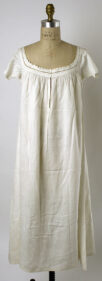
Chemises, drawers, and petticoats were made of white cotton fiber or linen. The chemise was the primary layer of clothing all women wore. Since it was the only part of the wardrobe to affect the body straight, this loose-plumbing fixtures garment absorbed sweat and kept the outer garments (which were much more than complicated to launder) clean. This meant that only undergarments needed to be laundered regularly, ensuring that the dresses would terminal many years while maintaining their color, structural integrity, and embellishments—which could easily exist damaged by frequent washing.
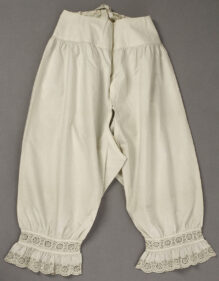
Drawers were long, loose-fitting "underpants" that separate and overlapped in the middle to permit for easy bathroom admission (they could not be pulled down in one case the corset was on). They covered a woman'southward legs to but beneath the knee and were more for modesty and functional utilise than style. 1 had to ensure, after all, that a carelessly lifted hoop brim would not accidentally reveal anything a lady would non want revealed!
Stockings were typically worn up over the articulatio genus. Made of wool, cotton, linen, or silk, they were held up past knitted or woven garters or ribbon tied above or beneath the knee joint and could be folded over, or not, according to personal selection. Silk and embroidered stockings were more expensive options. Stockings came in all different colors, although white and black were common choices for boilerplate apply.
Corsets were basically a support garment for the dorsum and chest, not unlike the sports bra is today. A woman put on her corset before her petticoats to aid back up the hips, the extra weight added by other clothing layers, and the multiple petticoats worn to achieve the bell shape that was popular in the mid-19th century. They were designed for unlike purposes, such as ventilated ones for summer, maternity wear, and for concrete work. Some men wore corsets besides!
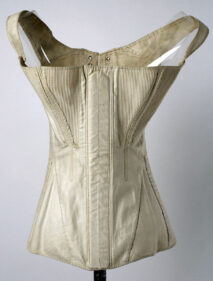
In virtually cases, corsets were fabricated to fit the owner's proportions. They were made of a combination of fabrics chosen for strength and style, and had channels sewn into them where whalebone, reed, or metal bones would be inserted to reinforce their shape. The corset would go through a period of "seasoning" during which the wearer's body heat would aid mold the corset to them, creating even more of a customized fit.
Many of our negative ideas or misconceptions regarding corsets come from fictional accounts, doctored photos, unrealistic portrayals from manner plates, Hollywood, or even from surviving garments that we see on display in museums and in archives. It is important to recognize that, more frequently than not, the garments that survive and finish up in museums were considered special and not worn on a daily ground. They oft come from the social elite, the fashionistas of the day who could appoint in extreme fashion simply like today'due south celebrities. Maybe not so surprisingly, corsets became a popular subject field of debate equally the women'due south rights movement began.
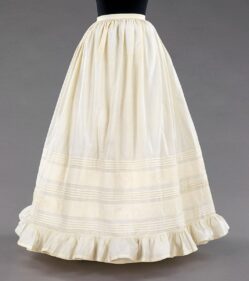
Depending on the plans for the day, a adult female would cull how many petticoats and crinolines she would article of clothing. A petticoat was a simple underskirt, whereas a crinoline was stiffened and more structured. Simple twenty-four hours or work dresses were worn with just petticoats underneath, regardless of social grade, because information technology allowed a woman to motility most much more easily. The number of petticoats worn depended on the style of dress; equally many as viii starched petticoats could be worn underneath a day dress to achieve the iconic bell shape. At to the lowest degree one of these petticoats would often be a corded petticoat. Like the corset, channels would exist sewn into the petticoat and horsehair, cabbage (bit material), or whalebone would be threaded through to make the skirts stand up at the proper angle. A final petticoat, called the over-petticoat, would be worn over the corded ane to smoothen out the look of the skirts.
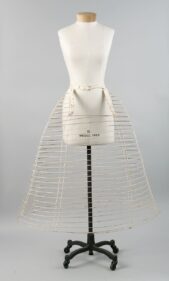
Early crinoline was stiffened much like the corded petticoat. The cage crinoline was invented in the mid-1800s and was constructed to have a framework made of steel, whalebone, or cane. When worn underneath a dress, the "hoop skirt" would flare out, helping to reach the illusion of a tiny waist, and an over-petticoat would be placed over the muzzle to smooth over the ridges.
Finally, on top of the petticoats and the crinolines was the terminal layer of a woman'south wardrobe: the dress.
Dresses were made in a wide range of fabrics, colors, patterns, and designs. They could either be a unmarried piece or two pieces comprised of a split skirt and bodice. If a woman was attention a party or fancy brawl, she would invest in a more structured and complicated apparel, which would certainly be worn with a crinoline. Catherine and Sarah Irving, Washington Irving's nieces, who along with their widowed father and iii younger sisters came to live at Sunnyside in 1840, would accept had at least two dresses for social gatherings and day dresses that were worn around the business firm. Day dresses were also appropriate for teatime and greeting visitors into one'due south domicile.
It might seem odd that women of a middle class household had far fewer dresses than a woman today. Before our electric current expectations of "fast fashion" and mass manufacturing, wear was valuable, often handcrafted, unique, and expensive, with so much time and try put into its brandish. Although the industrialization of textiles and other household items proliferated in the xixthursday century, these items were still more valuable than their counterparts today.
There are other ways that 19th-century societal norms play out in clothing. For instance, eye form women like the Irving nieces would not have been responsible for washing their own undergarments. Instead, the family hired laundresses for this work. Center course women also lived under sure expectations of behavior that are different than today. It was considered unseemly for women like the Irvings to exert themselves physically. A popular game from the fourth dimension was called "Graces," named for the way that a woman should look while playing. In this game, girls or women tossed a hoop dorsum and forth by using a pair of crossed sticks to throw the hoop. The players were not to heighten their arms too loftier, which would accept been inappropriate for a lady.
The period attire worn by our interpreters at Historic Hudson Valley helps convey a broader sense of the time periods for each of our sites. At Sunnyside, guides wear both simple dresses, like those of the servants, every bit well every bit the more elaborate hoop skirts that the nieces would have worn on more special occasions. Wear is one layer of interpretation that tells a much larger story of domestic, social, and even political history. The next time you lot go dressed, consider—what exercise our clothing choices say about u.s.a. today?
0 Response to "What Women's Fashion Was Asked to Be Given Up"
Post a Comment